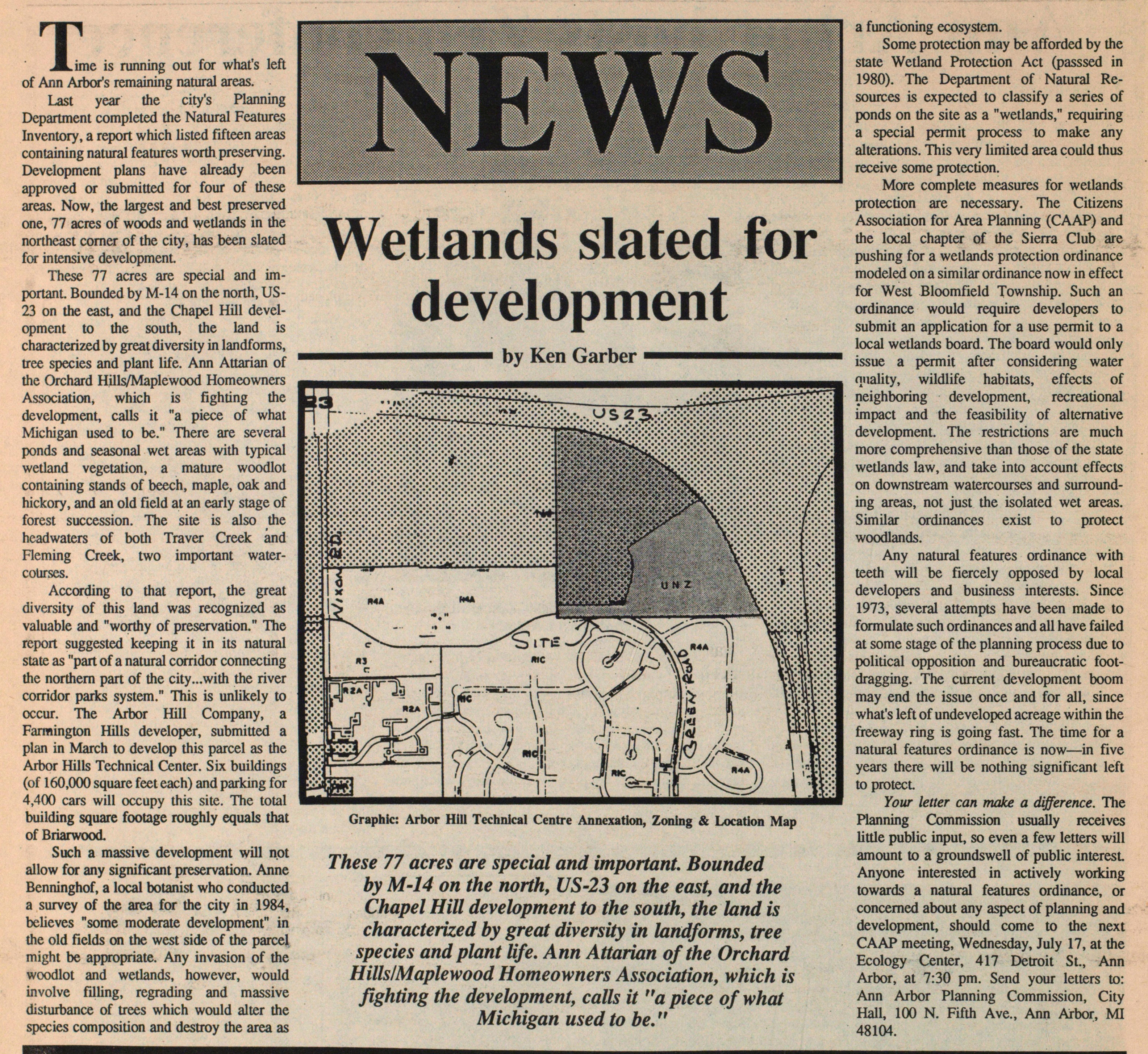Wetlands Slated For Development

Wetlands slated for development, by Ken Garber
Time is running out for what's left of Ann Arbor's remaining natural areas.
Last year the city's Planning Department completed the Natural Features Inventory, a report which listed fifteen areas containing natural features worth preserving. Development plans have already been approved or submitted for four of these areas. Now, the largest and best preserved one, 77 acres of woods and wetlands in the northeast corner of the city, has been slated for intensive development.
These 77 acres are special and important. Bounded by M-14 on the north, US-23 on the east, and the Chapel Hill development to the south, the land is characterized by great diversity in landforms, tree species and plant life. Ann Attarian of the Orchard Hills/Maplewood Homeowners Association, which is fighting the development, calls it "a piece of what Michigan used to be." There are several ponds and seasonal wet areas with typical wetland vegetation, a mature woodlot containing stands of beech, maple, oak and hickory, and an old field at an early stage of forest succession. The site is also the headwaters of both Traver Creek and Reming Creek, two important watercourses.
According to that report, the great diversity of this land was recognized as valuable and "worthy of preservation." The report suggested keeping it in its natural state as "part of a natural corridor connecting the northern part of the city...with the river corridor parks system." This is unlikely to occur. The Arbor Hill Company, a Farmington Hills developer, submitted a plan in March to develop this parcel as the Arbor Hills Technical Center. Six buildings (of 160,000 square feet each) and parking for 4,400 cars will occupy this site. The total building square footage roughly equals that of Briarwood.
Such a massive development will not allow for any significant preservation. Anne Benninghof, a local botanist who conducted a survey of the area for the city in 1984, believes "some moderate development" in the old fields on the west side of the parcel might be appropriate. Any invasion of the woodlot and wetlands, however, would involve filling, regrading and massive disturbance of trees which would alter the species composition and destroy the area as a functioning ecosystem.
Some protection may be afforded by the state Wetland Protection Act (passed in 1980). The Department of Natural Resources is expected to classify a series of ponds on the site as a "wetlands," requiring a special permit process to make any alterations. This very limited area could thus receive some protection.
More complete measures for wetlands protection are necessary. The Citizens Association for Area Planning (CAAP) and the local chapter of the Sierra Club are pushing for a wetlands protection ordinance modeled on a similar ordinance now in effect for West Bloomfield Township. Such an ordinance would require developers to submit an application for a use permit to a local wetlands board. The board would only issue a permit after considering water quality, wildlife habitats, effects of neighboring development, recreational impact and the feasibility of alternative development. The restrictions are much more comprehensive than those of the state wetlands law, and take into account effects on downstream watercourses and surrounding areas, not just the isolated wet areas. Similar ordinances exist to protect woodlands.
Any natural features ordinance with teeth will be fiercely opposed by local developers and business interests. Since 1973, several attempts have been made to formulate such ordinances and all have failed at some stage of the planning process due to political opposition and bureaucratic foot-dragging. The current development boom may end the issue once and for all, since what's left of undeveloped acreage within the freeway ring is going fast. The time for a natural features ordinance is now - in five years there will be nothing significant left to protect.
Your letter can make a difference. The Planning Commission usually receives little public input, so even a few letters will amount to a groundswell of public interest. Anyone interested in actively working towards a natural features ordinance, or concerned about any aspect of planning and development, should come to the next CAAP meeting, Wednesday, July 17, at the Ecology Center, 417 Detroit St., Ann Arbor, at 7:30 pm. Send your letters to: Ann Arbor Planning Commission, City Hall, 100 N. Fifth Ave., Ann Arbor, MI 48104.